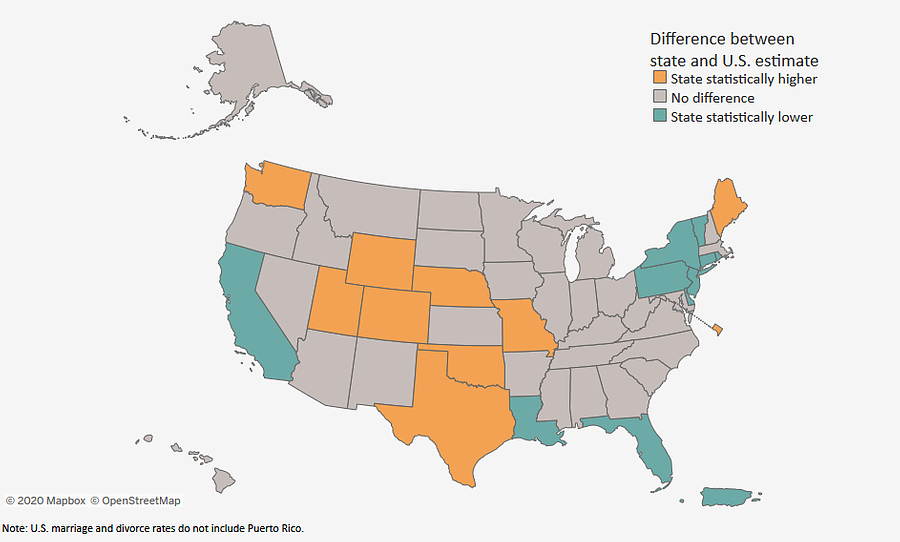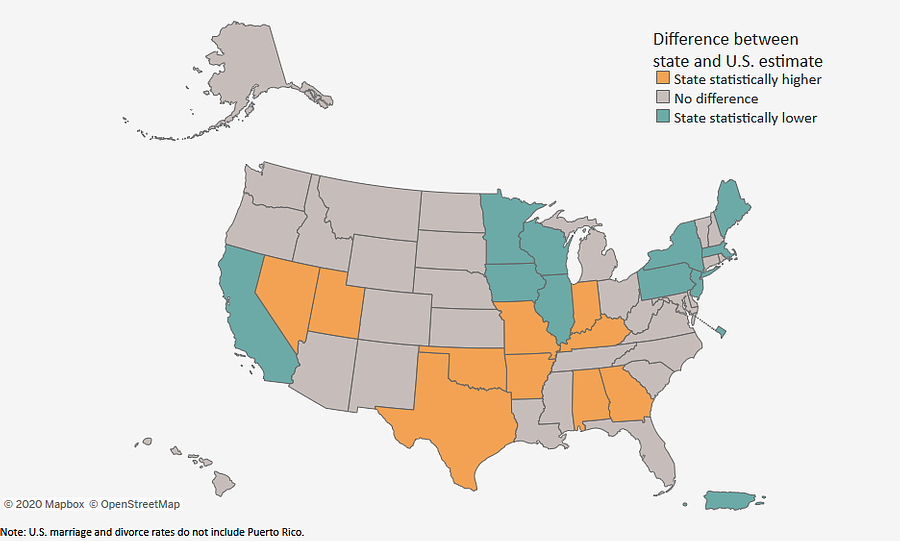
Making Information Make Sense
InfoMatters
Category: Research / Topics: Change • Demographics • Statistics • Trends
Marriage Trends
compiled by Stu Johnson
 Building article list (this could take a few moments)...
Building article list (this could take a few moments)...Posted: December 347, 2020
Marriage and divorce decline as cohabitation rises among younger couples…
Following are excerpts from three reports from the U.S. Census Bureau
U.S. Marriage and Divorce Rates Declined in Last 10 Years
From a report by Lydia Anderson and Zachary Scheret, statisticians in the Census Bureau's Social, Economic, and Housing Division - December 7, 2020
Both marriage and divorce rates in the United States declined from 2009 to 2019 but rates vary from state to state.
In 2019, there were 16.3 new marriages for every 1,000 women age 15 and over in the United States, down from 17.6 in 2009.
At the same time, the U.S. divorce rate fell from 9.7 new divorces per 1,000 women age 15 and over in 2009 to 7.6 in 2019.
How do the marriage and divorce rates in your state compare to the national average? How do they stack up to those in other states?
Now, an updated U.S. Census Bureau visualization allows you to rank and compare. It shows state-by-state marriage and divorce rates using data from the 2009 and 2019 American Community Survey 1-year estimates.
In 2019:
- Wyoming's marriage rate was among the highest in the nation.
- Delaware's marriage rate was among the lowest.
- Arkansas' divorce rate was among the highest.
- Divorce rates in the District of Columbia and Maine were among the lowest in the nation.
Marriage Trend, by State
Divorce Trend, by State
How does your state compare? To see interactive versions of these maps and other charts, go to the full version of the report on the U.S. Census Bureau website.
The report on marriage trends contains links to two other related reports::
For Young Adults, Cohabitation is Up, Marriage is Down
Living with an Unmarried Partner Now Common for Young Adults"
from a report by Benjamin Gurrentz, a survey statistician in the Census Bureau's Fertility and Family Branch - November 15, 2018
For some young adults, living together has become a more common option than marriage, according to new U.S. Census Bureau estimates released today.
The annual America’s Families and Living Arrangements tables package shows that the proportion of young adults who live with an unmarried partner continues to rise.
Among those ages 18-24, cohabitation is now more prevalent than living with a spouse: 9 percent live with an unmarried partner in 2018, compared to 7 percent who live with a spouse.
In 2018, 15 percent of young adults ages 25-34 live with an unmarried partner, up from 12 percent 10 years ago.
How Times Have Changed
Fifty years ago, in 1968, living with an unmarried partner was rare. Only 0.1 percent of 18- to 24-year-olds and 0.2 percent of 25- to 34-year-olds lived with an unmarried partner, according to the Current Population Survey.
The measurement of cohabitation from 1968-1995 was less precise. The estimate came from an indirect measure of opposite-sex partners sharing living quarters, and the late 1960s through the early 1970s had particularly low reports of cohabitation.
Also, when comparing 2008 to 2018, years in which the Current Population Survey asked a direct cohabitation question, cohabitation only increased for 25- to 34-year-olds and slightly decreased for 18- to 24-year-olds.
So, although cohabitation has increased for young adults over the last 50 years, it is important to note the limitations in measurement and that certain periods of time did not produce increases in unmarried young adults living together.
In contrast to the rising rates of cohabitation, the proportion of young adults who are married has declined over time.
Today, 30 percent of young adults ages 18-34 are married, but 40 years ago, in 1978, 59 percent of young adults were married. . . .
The Upside of Divorce?
When Laws Make Divorce Easier, Research Shows Women Benefit, Outcomes Improve
Frpm a report by Misty L. Heggeness, a principal economist and senior advisor in the Research and Methodology Directorate at the U.S. Census Bureau.- December 18, 2019.
Divorce usually conjures negative thoughts of broken homes and acrimony but research now shows that divorce laws can actually have a positive effect on society and the economy.
According to new research, laws that make it easier to divorce can improve the welfare of household members, even for couples that stay together.
Divorce can be difficult and lead to less than ideal well-being outcomes. But studies both abroad and in the United States show divorce laws can play a positive role.
When family laws shift property rights and provide payments directly to women upon divorce, wives have been shown to invest more in quality schooling for their children and in schooling in general. Their leisure time increases and they start working more, decreasing the time they spend on household chores such as cleaning and cooking.
The design of laws can also improve the welfare of all family members by helping to reduce violence or stress associated with intra-marital fighting. Making divorce easier reduces the costs associated with leaving an abusive or unhappy marriage. . . .
This article was also posted on SeniorLifestyle, which Stu edits
Posted: December 347, 2020 Accessed 4,050 times
![]() Go to the list of most recent InfoMatters Blogs
Go to the list of most recent InfoMatters Blogs
![]() Search InfoMatters (You can expand the search to the entire site)
Search InfoMatters (You can expand the search to the entire site)
 Loading requested view (this could take a few moments)...
Loading requested view (this could take a few moments)...InfoMatters
Category: Research / Topics: Change • Demographics • Statistics • Trends
Marriage Trends
compiled by Stu Johnson
 Building article list (this could take a few moments)...
Building article list (this could take a few moments)...Posted: December 347, 2020
Marriage and divorce decline as cohabitation rises among younger couples…
Following are excerpts from three reports from the U.S. Census Bureau
U.S. Marriage and Divorce Rates Declined in Last 10 Years
From a report by Lydia Anderson and Zachary Scheret, statisticians in the Census Bureau's Social, Economic, and Housing Division - December 7, 2020
Both marriage and divorce rates in the United States declined from 2009 to 2019 but rates vary from state to state.
In 2019, there were 16.3 new marriages for every 1,000 women age 15 and over in the United States, down from 17.6 in 2009.
At the same time, the U.S. divorce rate fell from 9.7 new divorces per 1,000 women age 15 and over in 2009 to 7.6 in 2019.
How do the marriage and divorce rates in your state compare to the national average? How do they stack up to those in other states?
Now, an updated U.S. Census Bureau visualization allows you to rank and compare. It shows state-by-state marriage and divorce rates using data from the 2009 and 2019 American Community Survey 1-year estimates.
In 2019:
- Wyoming's marriage rate was among the highest in the nation.
- Delaware's marriage rate was among the lowest.
- Arkansas' divorce rate was among the highest.
- Divorce rates in the District of Columbia and Maine were among the lowest in the nation.
Marriage Trend, by State
Divorce Trend, by State
How does your state compare? To see interactive versions of these maps and other charts, go to the full version of the report on the U.S. Census Bureau website.
The report on marriage trends contains links to two other related reports::
For Young Adults, Cohabitation is Up, Marriage is Down
Living with an Unmarried Partner Now Common for Young Adults"
from a report by Benjamin Gurrentz, a survey statistician in the Census Bureau's Fertility and Family Branch - November 15, 2018
For some young adults, living together has become a more common option than marriage, according to new U.S. Census Bureau estimates released today.
The annual America’s Families and Living Arrangements tables package shows that the proportion of young adults who live with an unmarried partner continues to rise.
Among those ages 18-24, cohabitation is now more prevalent than living with a spouse: 9 percent live with an unmarried partner in 2018, compared to 7 percent who live with a spouse.
In 2018, 15 percent of young adults ages 25-34 live with an unmarried partner, up from 12 percent 10 years ago.
How Times Have Changed
Fifty years ago, in 1968, living with an unmarried partner was rare. Only 0.1 percent of 18- to 24-year-olds and 0.2 percent of 25- to 34-year-olds lived with an unmarried partner, according to the Current Population Survey.
The measurement of cohabitation from 1968-1995 was less precise. The estimate came from an indirect measure of opposite-sex partners sharing living quarters, and the late 1960s through the early 1970s had particularly low reports of cohabitation.
Also, when comparing 2008 to 2018, years in which the Current Population Survey asked a direct cohabitation question, cohabitation only increased for 25- to 34-year-olds and slightly decreased for 18- to 24-year-olds.
So, although cohabitation has increased for young adults over the last 50 years, it is important to note the limitations in measurement and that certain periods of time did not produce increases in unmarried young adults living together.
In contrast to the rising rates of cohabitation, the proportion of young adults who are married has declined over time.
Today, 30 percent of young adults ages 18-34 are married, but 40 years ago, in 1978, 59 percent of young adults were married. . . .
The Upside of Divorce?
When Laws Make Divorce Easier, Research Shows Women Benefit, Outcomes Improve
Frpm a report by Misty L. Heggeness, a principal economist and senior advisor in the Research and Methodology Directorate at the U.S. Census Bureau.- December 18, 2019.
Divorce usually conjures negative thoughts of broken homes and acrimony but research now shows that divorce laws can actually have a positive effect on society and the economy.
According to new research, laws that make it easier to divorce can improve the welfare of household members, even for couples that stay together.
Divorce can be difficult and lead to less than ideal well-being outcomes. But studies both abroad and in the United States show divorce laws can play a positive role.
When family laws shift property rights and provide payments directly to women upon divorce, wives have been shown to invest more in quality schooling for their children and in schooling in general. Their leisure time increases and they start working more, decreasing the time they spend on household chores such as cleaning and cooking.
The design of laws can also improve the welfare of all family members by helping to reduce violence or stress associated with intra-marital fighting. Making divorce easier reduces the costs associated with leaving an abusive or unhappy marriage. . . .
This article was also posted on SeniorLifestyle, which Stu edits
Posted: December 347, 2020 Accessed 4,051 times
![]() Go to the list of most recent InfoMatters Blogs
Go to the list of most recent InfoMatters Blogs
![]() Search InfoMatters (You can expand the search to the entire site)
Search InfoMatters (You can expand the search to the entire site)
 Loading requested view (this could take a few moments)...
Loading requested view (this could take a few moments)...InfoMatters
Category: Research / Topics: Change • Demographics • Statistics • Trends
Marriage Trends
compiled by Stu Johnson
 Building article list (this could take a few moments)...
Building article list (this could take a few moments)...Posted: December 347, 2020
Marriage and divorce decline as cohabitation rises among younger couples…
Following are excerpts from three reports from the U.S. Census Bureau
U.S. Marriage and Divorce Rates Declined in Last 10 Years
From a report by Lydia Anderson and Zachary Scheret, statisticians in the Census Bureau's Social, Economic, and Housing Division - December 7, 2020
Both marriage and divorce rates in the United States declined from 2009 to 2019 but rates vary from state to state.
In 2019, there were 16.3 new marriages for every 1,000 women age 15 and over in the United States, down from 17.6 in 2009.
At the same time, the U.S. divorce rate fell from 9.7 new divorces per 1,000 women age 15 and over in 2009 to 7.6 in 2019.
How do the marriage and divorce rates in your state compare to the national average? How do they stack up to those in other states?
Now, an updated U.S. Census Bureau visualization allows you to rank and compare. It shows state-by-state marriage and divorce rates using data from the 2009 and 2019 American Community Survey 1-year estimates.
In 2019:
- Wyoming's marriage rate was among the highest in the nation.
- Delaware's marriage rate was among the lowest.
- Arkansas' divorce rate was among the highest.
- Divorce rates in the District of Columbia and Maine were among the lowest in the nation.
Marriage Trend, by State
Divorce Trend, by State
How does your state compare? To see interactive versions of these maps and other charts, go to the full version of the report on the U.S. Census Bureau website.
The report on marriage trends contains links to two other related reports::
For Young Adults, Cohabitation is Up, Marriage is Down
Living with an Unmarried Partner Now Common for Young Adults"
from a report by Benjamin Gurrentz, a survey statistician in the Census Bureau's Fertility and Family Branch - November 15, 2018
For some young adults, living together has become a more common option than marriage, according to new U.S. Census Bureau estimates released today.
The annual America’s Families and Living Arrangements tables package shows that the proportion of young adults who live with an unmarried partner continues to rise.
Among those ages 18-24, cohabitation is now more prevalent than living with a spouse: 9 percent live with an unmarried partner in 2018, compared to 7 percent who live with a spouse.
In 2018, 15 percent of young adults ages 25-34 live with an unmarried partner, up from 12 percent 10 years ago.
How Times Have Changed
Fifty years ago, in 1968, living with an unmarried partner was rare. Only 0.1 percent of 18- to 24-year-olds and 0.2 percent of 25- to 34-year-olds lived with an unmarried partner, according to the Current Population Survey.
The measurement of cohabitation from 1968-1995 was less precise. The estimate came from an indirect measure of opposite-sex partners sharing living quarters, and the late 1960s through the early 1970s had particularly low reports of cohabitation.
Also, when comparing 2008 to 2018, years in which the Current Population Survey asked a direct cohabitation question, cohabitation only increased for 25- to 34-year-olds and slightly decreased for 18- to 24-year-olds.
So, although cohabitation has increased for young adults over the last 50 years, it is important to note the limitations in measurement and that certain periods of time did not produce increases in unmarried young adults living together.
In contrast to the rising rates of cohabitation, the proportion of young adults who are married has declined over time.
Today, 30 percent of young adults ages 18-34 are married, but 40 years ago, in 1978, 59 percent of young adults were married. . . .
The Upside of Divorce?
When Laws Make Divorce Easier, Research Shows Women Benefit, Outcomes Improve
Frpm a report by Misty L. Heggeness, a principal economist and senior advisor in the Research and Methodology Directorate at the U.S. Census Bureau.- December 18, 2019.
Divorce usually conjures negative thoughts of broken homes and acrimony but research now shows that divorce laws can actually have a positive effect on society and the economy.
According to new research, laws that make it easier to divorce can improve the welfare of household members, even for couples that stay together.
Divorce can be difficult and lead to less than ideal well-being outcomes. But studies both abroad and in the United States show divorce laws can play a positive role.
When family laws shift property rights and provide payments directly to women upon divorce, wives have been shown to invest more in quality schooling for their children and in schooling in general. Their leisure time increases and they start working more, decreasing the time they spend on household chores such as cleaning and cooking.
The design of laws can also improve the welfare of all family members by helping to reduce violence or stress associated with intra-marital fighting. Making divorce easier reduces the costs associated with leaving an abusive or unhappy marriage. . . .
This article was also posted on SeniorLifestyle, which Stu edits
Posted: December 347, 2020 Accessed 4,052 times
![]() Go to the list of most recent InfoMatters Blogs
Go to the list of most recent InfoMatters Blogs
![]() Search InfoMatters (You can expand the search to the entire site)
Search InfoMatters (You can expand the search to the entire site)
 Loading requested view (this could take a few moments)...
Loading requested view (this could take a few moments)...




